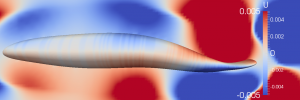Non linear interpolation via optimal transport
Optimal transportation problem is increasingly used to model problems in mechanics, physics, image analysis and other fields. Because of these applications, this old topic first introduced by G. Monge in 1789 attract considerable attention especially from a numerical point of view. The idea of the optimal mass transportation is to find an optimal mapping which realizes the transfer of a density to another one.
Our research aim at the numerical development and the software implementation of algorithms to solve the standard and the generalized optimal transportation problems.
We propose numerical methods based on both Lagrangian and Eulerian approaches to approximate the L² -Monge-Kantorovich problem. Efficient numerical methods using a continuation approach and a Newton method are investigated.
We next apply our algorithms to the two following fields:
- Neurosciences : In collaboration with M. Colavita, F. Massa and G. Marsicano (INSERM), we analyse the Voltage-Sensitive Dye Imaging (VSDI) data which measure the dynamic neuronal activity in acute brain slices in physiological and pathological conditions. Using optimal transportation, we derive precise information on velocity fields, direction, spatial spreading and morphological constraints of stimulated neuronal activity in hippocampal circuits. This approach represents a novel and rational method to obtain several specific parameters describing in detail the modes of diffusion of depolarization signals in brain slices.
- Modeling and simulation of fish swimming : Optimal transportation is used to compute the fish velocity for the penalty method and to determine the intermediate level-set to simulate the fish swimming from a set of images describing at different instant the geometry of the fish.
Numerical simulations have been done in 3D.
Our futur works consist in modeling and developing numerical methods to generalize the optimal transportation problem. For example, we plan to include physiological and anatomical characteristics of the hippocampus slices in the mathematical model (anisotropic environment) for the neuroscience application.






